Using three-dimensional computer modelling, the ELKH-ELTE Astropolarimetry Research Group proposed a new explanation for the possible mechanism of the origin of orbits of some asteroid families in the Sun-Jupiter system, being in mean motion resonances with Jupiter. Additionally, they discovered two new asteroid families. The paper presenting these results was published in Acta Astronautica, the official journal of the International Academy of Astronautics.
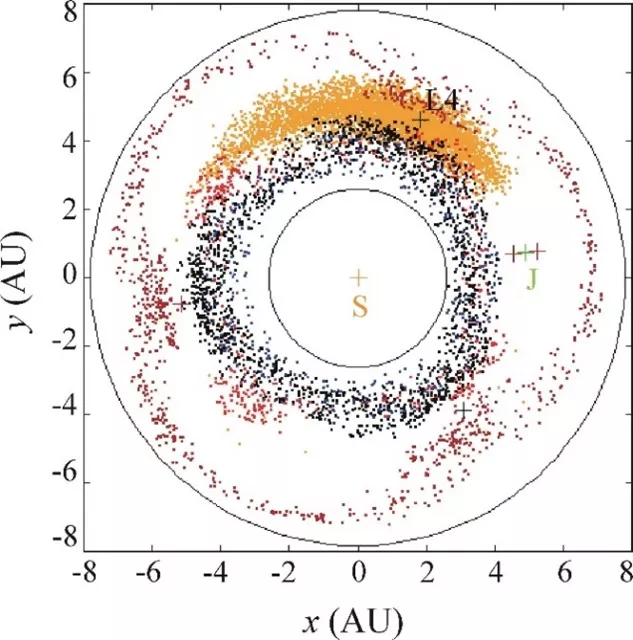
Figure 1: x-y projections of the final positions (after 7,000 Jupiter years) of trapped particles of a sphere with a radius of 1 AU (Astronomical Unit) centered around the stable L4 Lagrange point of the Sun-Jupiter system. The differently colored dots depict particles in different n:m mean motion resonances with Jupiter (while Jupiter completes n orbits, the particle runs m ones around the Sun) as follows: purple 4:3, orange 1:1, red 3:4, black 2:3, blue 5:8, 4:7 and 5:9. See: Video Clip 1 and Video Clip 2. (Source: Slíz-Balogh et al. 2023)
The mechanism that forms the different resonant families of the asteroid belt between the orbits of Jupiter and Mars is not completely understood. With numerical modelling of the 3-dimensional semi-analytical model of the Sun-Jupiter-particle system, Judit Slíz-Balogh, Dániel Horváth and Gábor Horváth, members of the ELKH-ELTE Astropolarimetry Research Group, studied a possible new capture mechanism of asteroid families in different n:m mean motion resonances with Jupiter (while Jupiter completes n orbits, the particle runs m ones around the Sun) (Figure 1, Video Clip 1, and Video Clip 2).
They examined the numbers and orbits of particles captured along the Jupiter’s present orbit (including the L3, L4 and L5 Lagrange points) for 7,000 Jupiter years. They found that not only the Trojan and Greek asteroid families (being in 1:1 resonance with Jupiter), but also the asteroid families in 4:3, 4:5, 3:4, 2:3, 5:8, 4:7 and 5:9 resonances may have formed from the asteroids captured, launched and kept on their orbits by the L3, L4, L5 Lagrange points and certain areas along the Jupiter’s path. Furthermore, they found two possible new asteroid families in 4:5 and 3:4 resonances with Jupiter, no member of which have yet been observed by astronomers. As an interesting part of this study, triangular, tetragonal, pentagonal (Figure 2, Video Clip 3) and horseshoe-shaped resonant asteroid orbits were also detected in computer simulations.
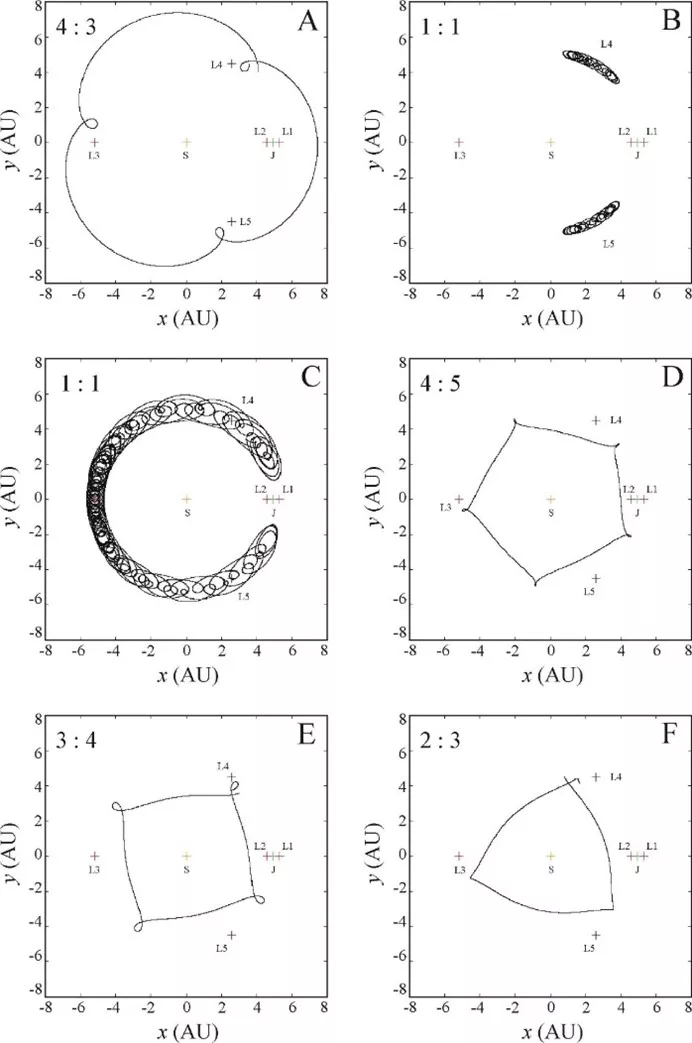
Figure 2: Trajectories of particles in 4:3 (A), 1:1 (B), 1:1 (C), 4:5 (see: Video Clip 3) (D), 3:4 (E), 2:3 (F) first-order resonances with Jupiter. A, D, E, F show m = 1 revolution, B represents m = 50 revolutions, and C displays m = 200 revolutions. The 4:5 and the 3:4 resonance families were not known earlier. (Source: Slíz-Balogh et al. 2023)
The net gravitation of Sun and Jupiter can frequently shepherd the asteroids to orbits around the Sun with regular geometric shapes. Thus, Sun and Jupiter form a gravitational shield which protects the planets and moons of the inner Solar System from asteroids coming from the outer zones, moving with speeds not significantly differing from that of the Jupiter.
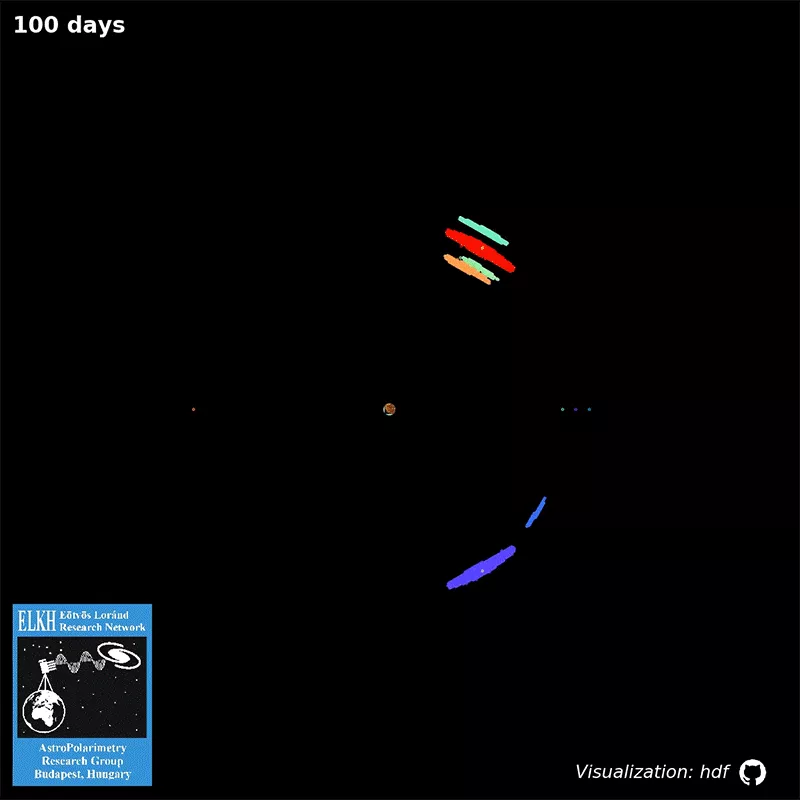
Video Clip 1: Simulated motion of particles [light green: 4:3 resonance, red: 1:1 resonance (L4), blue: 1:1 (L5) and 4:5 resonances, green: 3:4 resonance, orange: 2:3 resonance] starting from the vicinity of the triangular Lagrange points L4 (4:3, 1:1, 3:4 and 2:3 resonances) and L5 (1:1 resonance) of the Sun-Jupiter system and from an area along the Jupiter's orbit between L5 and Jupiter (4:5 resonance) visualized in a system of coordinates co-rotating with Jupiter. The starting point of time is τ = 0 Earth days, where τ is the time of Jupiter’s pericenter passage. The origin of the video frame is Sun (big orange dot). The simulation was performed in three dimensions (x-y-z), but here the visualization happens in the x-y plane coinciding with the Jupiter’s orbital plane. 69,420 particles were launched, the starting positions of which were uniformly distributed in the spherical initial domain (SID) with 1 AU radius centered around the L4 point. The small violet, blue, light blue, orange, yellow and green spots are Jupiter, L1, L2, L3, L4 and L5 Lagrange points, respectively. The time (day) is shown in the top left corner. The evolution of particles is displayed here for 20 Jupiter years after their capture. The dots representing Jupiter (J) and the L1, L2, L4, L5 points are wobbling in a system of coordinates corotating with J, because J together with L1, L2, L4, L5 revolve around Sun (S) along elliptic orbits in a non-rotating system of coordinates. Since L3 is coupled practically only to S due its large distance from J, it does not wobble, because S practically does not oscillate around the center of mass of the S-J system. (Source: Slíz-Balogh et al. 2023)
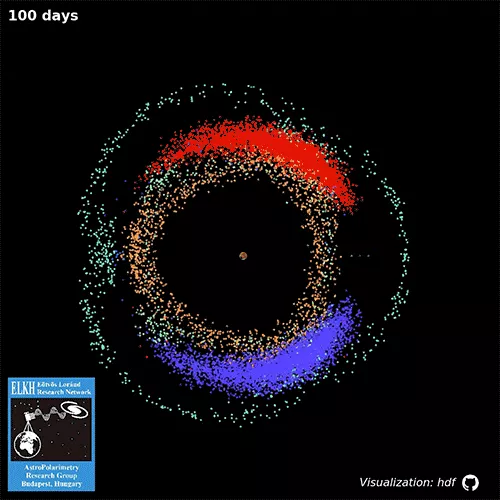
Video Clip 2: Simulated motion of particles [light green: 4:3 resonance, red: 1:1 resonance (L4), blue: 1:1 (L5) and 4:5 resonances, green: 3:4 resonance, orange: 2:3 resonance] starting from the vicinity of the triangular Lagrange points L4 (4:3, 1:1, 3:4 and 2:3 resonances) and L5 (1:1 resonance) of the Sun-Jupiter system and from an area along the Jupiter's orbit between L5 and Jupiter (4:5 resonance) visualized in a system of coordinates co-rotating with Jupiter. The starting point of time is τ = 0 Earth days, where τ is the time of Jupiter’s pericenter passage. The origin of the video frame is Sun (big orange dot). The simulation was performed in three dimensions (x-y-z), but here the visualization happens in the x-y plane coinciding with the Jupiter’s orbital plane. 69,420 particles were launched, the starting positions of which were uniformly distributed in the spherical initial domain (SID) with 1 AU radius centered around the L4 point. The small violet, blue, light blue, orange, yellow and green spots are Jupiter, L1, L2, L3, L4 and L5 Lagrange points, respectively. The time (day) is shown in the top left corner. The evolution of particles is displayed here from 7,000 to 7,020 Jupiter years after their capture. The dots representing Jupiter (J) and the L1, L2, L4, L5 points are wobbling in a system of coordinates corotating with J, because J together with L1, L2, L4, L5 revolve around Sun (S) along elliptic orbits in a non-rotating system of coordinates. Since L3 is coupled practically only to S due its large distance from J, it does not wobble, because S practically does not oscillate around the center of mass of the S-J system. (Source: Slíz-Balogh et al. 2023)
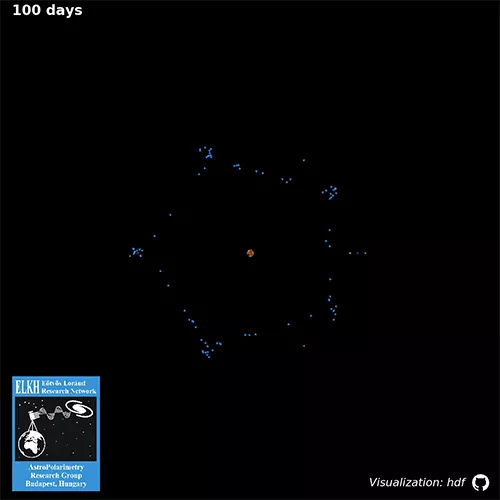
Video Clip 3: Simulated motion of particles (blue) along pentagon-shaped orbits in 4:5 mean motion resonance with Jupiter starting from between Jupiter and the L5 point of the Sun-Jupiter system visualized in a system of coordinates co-rotating with Jupiter with starting point of time τ = 0 Earth days, where τ is the time of Jupiter’s pericenter passage. The origin of the video frame is Sun (big orange dot). The simulation was performed in three dimensions (x-y-z), but here the visualization happens in the x-y plane coinciding with the Jupiter’s orbital plane. The initial linear velocity vector of the particles was the same as that of the L4 point belonging to τ = 3252 Earth days, while Sun and Jupiter were in their initial position corresponding to τ = 0 Earth days, where τ is the time of Jupiter’s pericenter passage. The small violet, blue, light blue, red, yellow and orange dots are Jupiter, L1, L2, L3, L4 and L5 Lagrange points, respectively. The time (day) is shown in the top left corner. The motion of particles is displayed from 7,000 to 7,020 Jupiter years after their capture. The dots representing Jupiter (J) and the L1, L2, L4, L5 points are wobbling in a system of coordinates corotating with J, because J together with L1, L2, L4, L5 revolve around Sun (S) along elliptic orbits in a non-rotating system of coordinates. Since L3 is coupled practically only to S due its large distance from J, it does not wobble, because S practically does not oscillate around the center of mass of the S-J system. (Source: Slíz-Balogh et al. 2023)
The research is supported by the grant ELKH-ELTE-0116607 (Construction and application of a portable imaging polarimetric astronomical telescope in areas with favourable astroclimate to study the interplanetary dust, especially the Kordylewski dust clouds) received from the Eötvös Loránd Research Network.
Publication:
Judit Slíz-Balogh, Dániel Horváth, Gábor Horváth (2023). Jupiter, the great celestial organizer:Oon the origin of orbits of some asteroid families in mean motion resonances with Jupiter. Acta Astronautica 211: 208-215 + electronic supplement. DOI: 10.1016/j.actaastro.2023.06.005